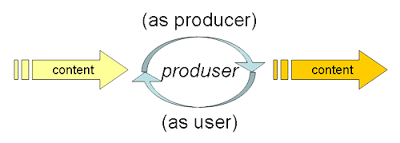The traditional role of the audience has now evolved. The media producer and audience roles are now being blurred and the traditional boundaries are now being crossed. “The relationship between audiences/consumers and corporate producers is undergoing significant transformation. Entities such as "audience", “fan”, “producer”, “corporation” and “consumer” are relational and emerge from continually transforming networks of relations,” (Banks 2002, 190). The break down of barriers between producers and audiences termed produsers, is a continuous collaborative process of creating, producing and circulating new content via social networking and tagging utilities such as Blogs or YouTube. "Indeed, even those members of the networked population who choose for the moment to remain users, simply utilising the 'products' of the produsage process as substitutes for industrial products, are always already potential produsers themselves - and recent developments have made it ever more easy, and in some cases even inevitable, for such users to become produsers (for example as their very patterns of usage become direct inputs to the continuing processes of produsage)," (Bruns 2007).
Media audiences expect media producers to listen to their opinions, views and effectively respond to feedback. In order to be successful, the producers of media now need to be responsive and discuss any concerns with their audience. The producer-audience relationship is an increasingly complex and multifaceted one (Banks 2002, 212). Media audience research and practice suggest audiences are elusive and slippery entities, difficult to pin down and categorise (Banks 2002, 190). The new audience of produsers are central, interactive, powerful and involved in creating content (Banks 2002, 190). It is an important topic for those interested in media because there is a real need to understand the complex nature of audiences and the shift from active to interactive audiences.
At first glimpse, audiences appear to be simple and easy to understand however is complex and involved below the surface. Audiences are the critical link in the communication process and are often used as a figure of speech by various groups in society to support claims. The move from active to interactive audiences has sparked an increase in interest from those interested in media. Interactive audiences are those who actively involve themselves in the media and relate it and decode it to their daily lives (Livingstone 2005, 31). A disadvantage of the active audience is the ability for them to possess too much power and an advantage is that the active audience has a greater understanding of media use (Jenkins 2002, 167; Livingstone 2005, 31).
Produsers are gaining new power and greater autonomy over media producers as they enter the new knowledge economy and transform into interactive audiences (Banks 2002, 212). The World Wide Web, Web 2.0, digital technologies, convergence, new media technologies, networked computing and the Internet all present possible reasons for the significant increase in the power of the audience. It also presents potential loss of intellectual property of media producer creation when power is given to the interactive audiences for media (Banks 2002, 197).
Produsers are now unpredictable and it is becoming more difficult to understand audiences. Due to this evolution, audiences now have a greater control over media companies and this is now the routine way the new media systems operates (Jenkins 2002, 167). There is also a dependability of new media industries on the voluntary, free labour creative production of collaborative, decentralised fan networks and audiences (Castells 2001, 102). “These developments are inducing a new model of relationship between property relations and production relations in the generation and appropriation of wealth. There are areas of cooperation and common appropriation, linked to areas of competition and private appropriation. While these trends are still embryonic, they may herald a profound transformation of the social logic of innovation, productivity, and economic growth,” (Castells 2001, 102).
References
Banks, J. 2002. Chapter 8: Gamers as co-creators: Enlisting the virtual audience - A report from the net face. In Mobilising the audience, ed. M. Balnaves, T. O'Regan and J. Sternberg, 188-212. Brisbane: University of Queensland Press.
Bruns, A. 2007. Produsage: A working definition. http://produsage.org/produsage (accessed 20 April 2007).
Castells, M. 2001. The Internet galaxy: Reflection on the Internet, business and society. New York: Oxford University Press.
Jenkins, H. 2002. Interactive audiences. In The new media book, D. Harries, 157-170. London: BFI Publishing.
Livingstone, S. 2005. Media audiences, interpreters and users. In Media audiences, ed. M. Gillespie, 10-50. Maidenhead: Open University Press.
Ross, Karen and Nightingale, Virginia. 2003. New media, new audience, new research? In Media and audiences: New perspectives, K. Ross and V. Nightingale, 146-165. Maidenhead: Open University Press.

No comments:
Post a Comment